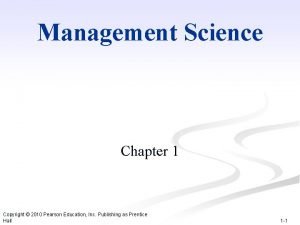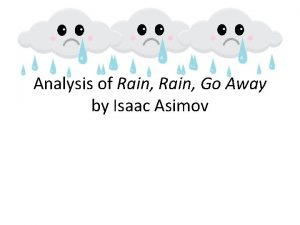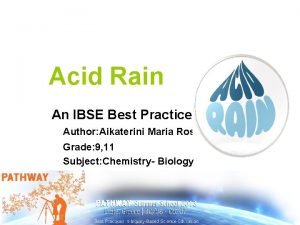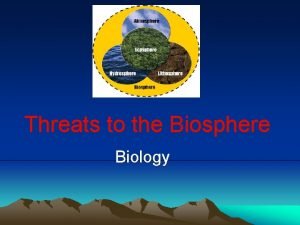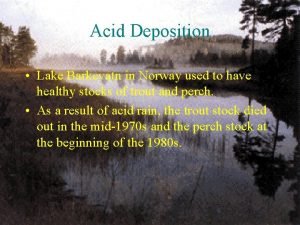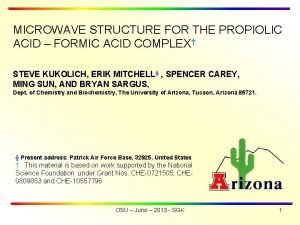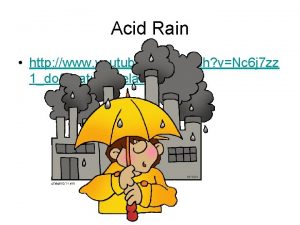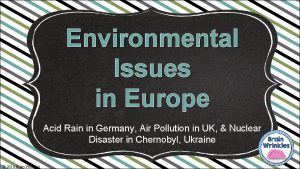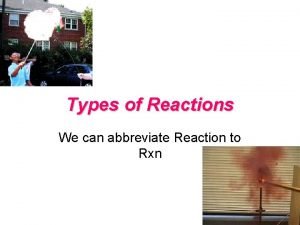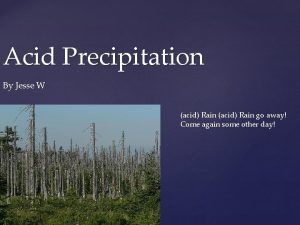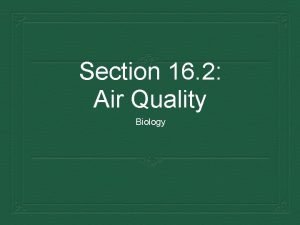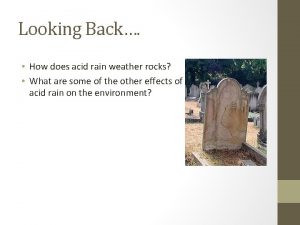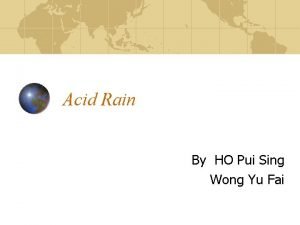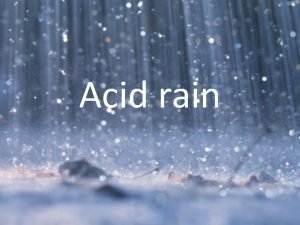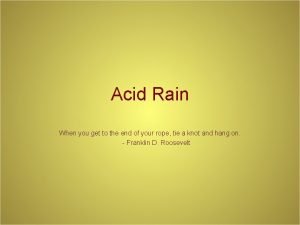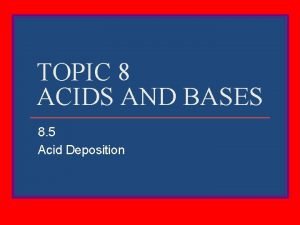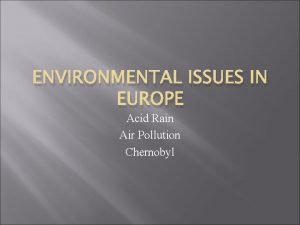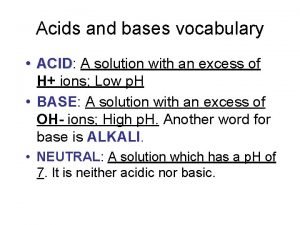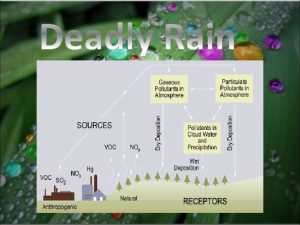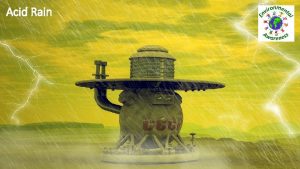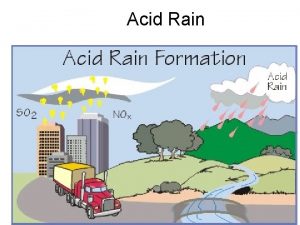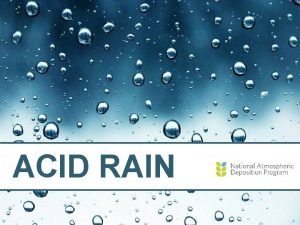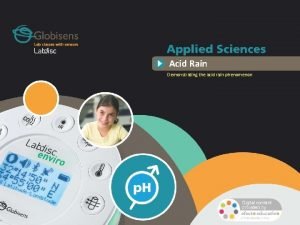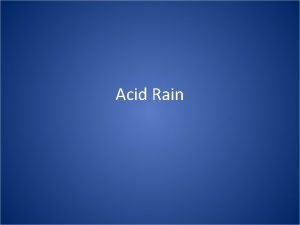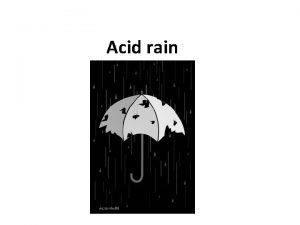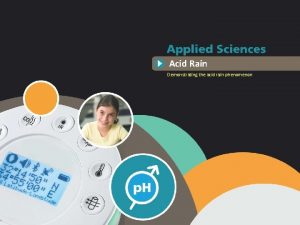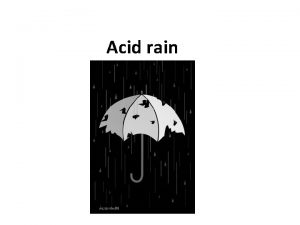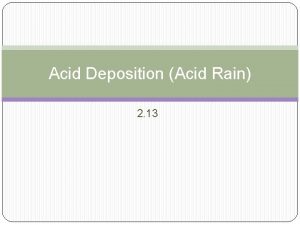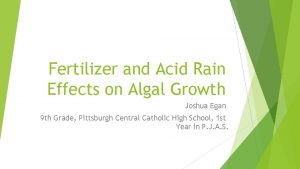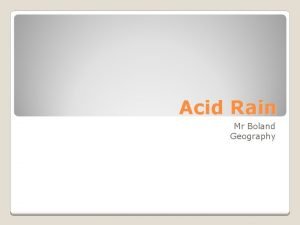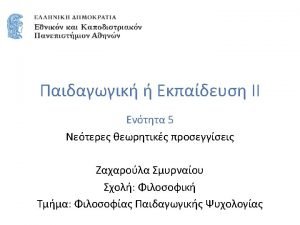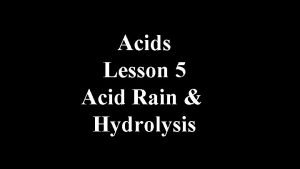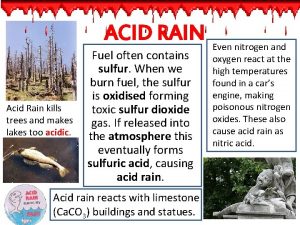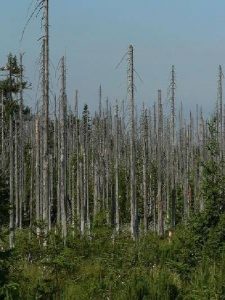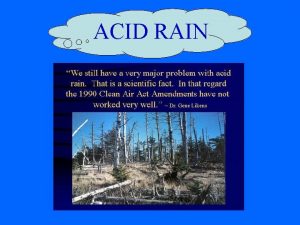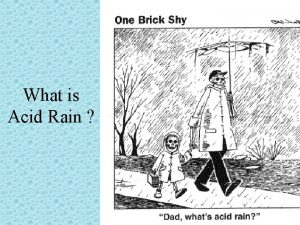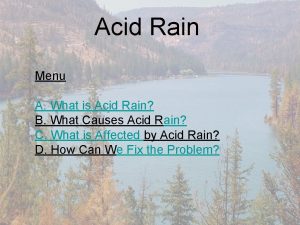Fertilizer Effects on Acid Rain Stressed Algae Andrew























- Slides: 23

Fertilizer Effects on Acid Rain Stressed Algae Andrew Haky 9 th Grade, Pittsburgh Central Catholic HS 1 st Year in P. J. A. S.

Runoff Part of the water cycle and describes the water that flows over a land surface. Surface runoff occurs on land, typically creating a ‘watershed. ’ ◦ Materials that are transported on surface runoff are fertilizers, petroleum, pesticides, herbicides, and salt. ◦ Pollution can come from this runoff

Algal Importance Base of aquatic food chain Used as a bio-indicator for aquatic environments

Eutrophication Caused by an overabundance of nutrients in an ecosystem No limiting factor on algae populations Uncontrollable growth takes up resources necessary for other organisms-oxygen. Limits biodiversity Can occur naturally Occurs today by fertilizer run off Serious Pollution Problem

Acid Precipitation Worldwide problem Caused by pollution of sulfur dioxide and nitrogen oxide Often originates from smokestacks, vehicle exhaust, and burning fossil fuels Average p. H of 5. 6 An increase of acid rain in many aquatic systems reduces biodiversity. 5

Acid Rain in Pennsylvania Average p. H of precipitation in PA: 4. 5 o Major problem due to industry o The many abandoned coal mines in PA create a large problem for the water bodies in the area o 6

The main ingredients in Miracle-Gro are Nitrogen, Phosphates and Potash. q. Nitrogen- found in ammonia used in fertilizers, causes algae populations to grow rapidly(eutrophication) q Phosphates are vital for cellular processes such as the synthesis of ATP and ADP. q. Both phosphates and nitrogen are normally limiting factors of algal populations.

Sulfuric Acid Potash v Top product in chemical v Potassium oxide in industry fertilizers v Can be combined with v 93% used to make ammonia to create fertilizers agricultural products v Important for food crops, v Corrosive, can bind with water droplets to create gives them favorable acid rain qualities v Canada is the world’s leading producer Potash and H 2 SO 4

Chlamydomonas Used as a bio-indicator Genus of green algae Can create starch Has an Eyespot to orient itself to light Two flagella, swims with a breaststroke-like motion 10 μm in diameter Large, crescent-shaped chloroplasts Found in freshwater, soil, oceans, and snow 9

Euglena Protist Euglenophyte because of chloroplasts 20 -300 μm in length Endocytosis Flagellum propels with whip-like motion Can also make an inchworm-like movement Has an Eyespot to orient itself towards light Found in nutrient-rich freshwater Effected by acidity Asexual, prokaryotic fission 10

Purpose Determine if fertilizers (Miracle-Gro) and acid rain (H 2 SO 4 ) have an effect on algae populations (Euglena and Chlamydomonas) individually or in synergy.

Hypothese s NULL- neither Miracle-Gro nor acidity will significantly affect algal population growth and they not act synergistically to affect growth

PROCEDUR E 1. 60 tubes were set up to receive equal light. 2. Chlamydomonas was added to half the tubes and Euglena to the other half. Tips were changed for each new content added. This was done throughout the experiment. Every tube for each group had equal concentrations of algae, although the Euglena concentration was half of the Chlamydomonas. 3. Miracle-Gro was added using a micropipet in 0, 0. 5, & 0. 05 m. L volumes to 10 tubes each to both Chlamydomonas and Euglena samples. 4. 0. 01 x Sulfuric Acid was added using a micropipet to 5 out of every 10 tubes in 0. 02 m. L, but not the other 5. Spring water was then added using a micropipet to make each tube 5 m. L full.

Steps 2 -5 created 30 tubes of Chlamydomonas. 15 tubes had a p. H of 7 and the other 15 tubes had a p. H of 5. For both of these groups, 5 tubes had a fertilizer concentration of 0 x, 5 had a concentration of 0. 001 x, and five had a concentration of 0. 1 x. The same was also done using Euglena. 6. Each tube was marked with a black line so that it would enter the spectrophotometer the same direction every time. 7. Wax paper was used to cover each tube. The tubes were each inverted 3 times. 8. The spectrophotometer was allowed to warm up for 30 minutes at 430 nm. 9. Each tube was placed into the spectrophotometer and the absorbance was taken. 10. After 19 days, the results were analyzed using statistics and graphs.

Chlamydomonas Sample’s Absorbance Reading (nm) 0. 7 0. 6 0. 5 0. 4 0. 3 0. 2 0. 1 0 1 3 5 7 9 12 15 19 Day of Experiment p. H 7, 0 x p. H 7, 0. 001 x p. H 7, . 1 x p. H 5, 0. 001 x p. H 5, . 1 x

Euglena Sample’s Absorbances 0. 2 Absrobaance Reading (nm) 0. 18 0. 16 0. 14 0. 12 0. 1 0. 08 0. 06 0. 04 0. 02 0 1 3 5 7 9 12 15 19 Day of Experiment p. H 7, 0 x p. H 7, 0. 001 x p. H 7, . 1 x p. H 5, 0. 001 x p. H 5, . 1 x

0. 18 Euglena Absorbance's: First & Last Days Average Absorbance of Sample Group 0. 16 0. 14 0. 12 0. 1 Day 1 0. 08 Day 19 0. 06 0. 04 0. 02 0 p. H 7, 0 x p. H 7, 0. 1 x p. H 5, 0 x 0. 001 x Sample Group p. H 5, 0. 1 x 0. 001 x

ØDid the p. H have an effect on the Chlamydomonas Samples at either 0 x, 0. 001 x, or 0. 1 x fertilizer concentrations? - Insignificant, the groups had p-values of >0. 05 (p-values were 0. 720 at 0 x, 0. 670 at 0. 001 x, and 0. 249 at 0. 1 x ACCEPT NULL ØDid the fertilizer concentrations have an effect on Chlamydomonas at a p. H of 5 or 7? - Significant, the p-value were: 7. 714 E-7 at p. H 7 & 3. 37 E-4 at p. H 5 REJECT NULL ØWas there an interaction between p. H and fertilizer concentration with the Chlamydomonas Samples? - Insignificant, the p-value of 0. 110516 is >0. 05 ACCEPT NULL ANOVAS Statistical Analysis Chlamydomonas

ØDid the p. H have an effect on the Euglena Samples at either 0 x, 0. 001 x, or 0. 1 x fertilizer concentrations? -Significant at 0 x (p-value of 0. 002). REJECT NULL Insignificant at 0. 001 x or 0. 1 x because p-values were > than 0. 05. (0. 473 at 0. 001 x & 0. 275 at 0. 1 x) ACCEPT NULL ØDid the fertilizer concentrations have an effect on Euglena at a p. H of 5 or 7? -Insignificant, the p-values were 0. 476 at p. H 7 & 0. 333 at p. H 5 ACCEPT NULL ØWas there an interaction between p. H and fertilizer concentration with the Euglena Sample? - Insignificant, the p-value of 0. 429 is >0. 05 ACCEPT NULL ANOVAS Statistical Analysis Euglena

Dunnet’s Test For the significant ANOVA’s, Dunnet’s tests were conducted to find which group(s) varied significantly from the control. ØChlamydomonas, p. H 7 - The samples with a fertilizer concentration of 0. 001 x did not vary significantly from the control but the 0. 1 x samples did. -T 2. 53<3. 03 T-crit [0. 001 x] T 10. 22>4. 63 T-crit [0. 1 x](very sure) ØChlamydomonas, p. H 5 - The samples with a fertilizer concentration of 0. 001 x did not vary significantly from the control but the 0. 1 x samples did. -T 1. 616< 3. 03 T-crit [0. 001 x] T 5. 620>4. 63 T-crit [0. 1 x] (very sure) ØEuglena, 0 x fertilizer- the p. H difference was found to be significant. -T 4. 378> 4. 03 T-crit (very sure)

CONCLUSIONS o. The null hypothesis is rejected because fertilizer concentration had an effect on Chlamydomonas and because p. H did have an effect on Euglena at 0 x. The null is accepted in that p. H did not effect Chlamydomonas and fertilizer concentration had no effect on Euglena. o. Research indicated Euglena would be effected by p. H level. This was supported at a 0 x fertilizer concentration. o. Eutrophication may have played a role in Euglena’s spike and drop. It is possible it could have effected Chlamydomonas at a later time.

Notes/Variables/Limits EXTENSIONS Ø Algae shock? Ø Euglena Tube <p. H 5, 0. 001 x> Ø Spectrometer accuracy Ø Cloudy and overcast days Ø Sample size limit Ø Could test thermal water pollution Ø Could test salt concentration Ø Use other organisms

Bibliography "http: //www. factmonster. com/ce 6/. html. " The Columbia Electronic Encyclopedia. © 1994, 2000 -2006, on Fact Monster. © 2000– 2007 Pearson Education, publishing as Fact Monster. 01 Jan. 2010 <http: //www. factmonster. com/ce 6/sci/A 0861351. html>. Cloern, James E. "Eutrophication. " Encyclopedia of Earth. 18 Dec. 2007. Web. 30 Dec. 2009. <http: //www. eoearth. org/article/Eutrophication>. Jones, Andrew Z. "Visible Light Spectrum. " Physics. New York Times Company. Web. 01 Jan. 2010. <http: //physics. about. com/od/lightoptics/a/vislightspec. htm>. Mackean, D. G. "Biology: Protista, Amoeba, Malaria, Paramecium, Spirogyra, Chlamydomonas, Euglena, Educational notes & drawings by D G Mackean. " Biology Teaching & Learning Resources. Educational articles, drawings, experiments & Power. Point presentations by D G Mackean and Ian Mackean. Web. 30 Dec. 2009. <http: //www. biologyresources. com/amoeba. html>. Ophardt, Charles E. "Acid Rain. " Elmhurst College: Elmhurst, Illinois. 2003. Web. 01 Jan. 2010. <http: //www. elmhurst. edu/~chm/vchembook/190 acidrain. html>. "sulfuric acid. " The Columbia Encyclopedia, Sixth Edition. 2008. Encyclopedia. com. 1 Jan. 2010 <http: //www. encyclopedia. com>. Kitajima, Yasuko. "Fertilizer. " Formal Reasoning Group. 19 June 1997. Web. 01 Jan. 2010. <http: //www-formal. stanford. edu/jmc/nature/node 23. html>.
 Evergreen fertilizer company produces fertilizer
Evergreen fertilizer company produces fertilizer Acid rain causes
Acid rain causes Rain rain go away isaac asimov
Rain rain go away isaac asimov Acid rain pathway
Acid rain pathway Acid rain map
Acid rain map Acid rain
Acid rain Acid rain reaction
Acid rain reaction Hcccooh
Hcccooh Https: //www. youtube. com/watch? v=r6nvnrisd5c
Https: //www. youtube. com/watch? v=r6nvnrisd5c Acid rain in canada
Acid rain in canada Acid rain in germany illustration
Acid rain in germany illustration Acid rain calcium carbonate
Acid rain calcium carbonate Acid rain facts
Acid rain facts Objectives of acid rain
Objectives of acid rain Copy and complete the following chart
Copy and complete the following chart How does acid rain weather rocks
How does acid rain weather rocks Lord acid rain
Lord acid rain Rainoutcomes
Rainoutcomes Acid rain
Acid rain Prevention of acid rain
Prevention of acid rain Statue of liberty before and after acid rain
Statue of liberty before and after acid rain Acid rain chernobyl
Acid rain chernobyl Acid vocabulary
Acid vocabulary Acid rain chemical reaction
Acid rain chemical reaction
